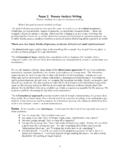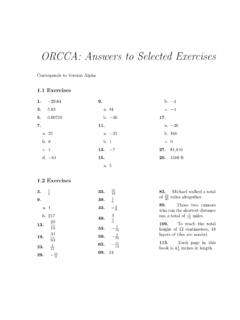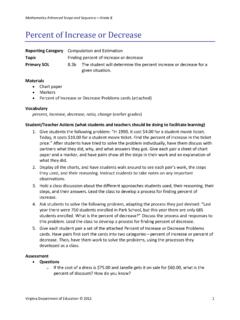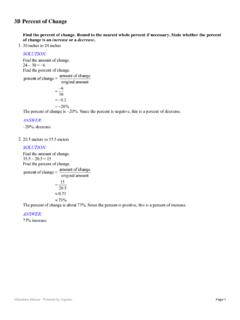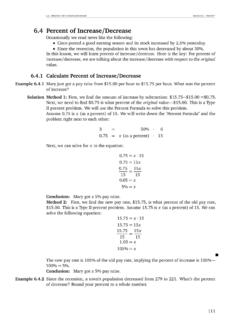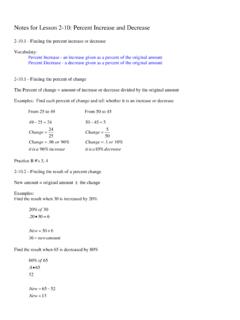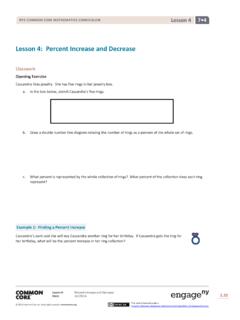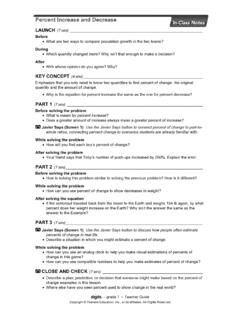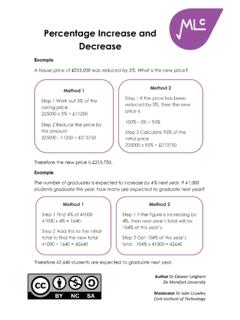Transcription of Percent of Increase and Decrease - PCC
1 Percent of Increase and Decrease Say a stock used to be worth $3 a share. Now it's $6. What's the Percent of Increase ? We know the Increase is $3. Now, we need to decide between the following two problems: The Increase $3 is what Percent of the original price $3? The answer would be 100% Increase . Or, the Increase $3 is what Percent of the new price $6? The answer would be 50% Increase . By common sense, if the stock goes from $3 per share to $6 per share, that's a 100% Increase . From this simple example, we learned that when we calculate the Percent of Increase , we need to ask: The Increase is what Percent of the ORIGINAL value. [Example 1] A pre-school used to have 20 students. Now it has 25 students. What's the Percent of Increase in the number of students? [Solution] The Increase is 25-20=5 students. We need to find 5 is what Percent of the original value 20. Let x be the Percent of Increase . We have: xxxxx==== =% Solution: The Percent of Increase in the number of students is 25%.
2 [Example 2] A pre-school used to have 25 students. Now it has 20 students. What's the Percent of Decrease in the number of students? [Solution] The Increase is 25-20=5 students. We need to find 5 is what Percent of the original value 25. Let x be the Percent of Decrease . We have: xxxxx==== =% Solution: The Percent of Decrease in the number of students is 20%. If the number goes from 20 to 25 (Example 2), that a 25% Increase . If the number goes from 25 to 20 (Example 3), that a 20% Decrease . Sometimes common sense just doesn't work! :) Example 3 also works against common sense. [Example 3] Tom makes $12 per hour at a pizza chain. He recently got a 5% salary Increase . Later, the whole chain's employees got a 5% salary Decrease due to the recession. Tom thought his salary would go back to $12 per hour, but it didn't! What's Tom's new salary? [Solution] Tom used to make $12 per hour, and he got a 5% salary Increase . To find the amount of Increase , we ask: What is 5% of $12?
3 By the Percent Formula, we have: =x The Increase was $ , so Tom's salary became $ after the Increase . Later, he got a 5% salary Decrease . We need to find: What is 5% of $ This time, we have: =x Solution: Since the Decrease was $ , Tom's new salary is $ $ $ per hour. Why didn't Tom's salary go back to $12 after a 5% Increase and a 5% Decrease ? This is because the 5% Decrease was based on a bigger number $ , compared to the 5% Increase based on a smaller number $ The following examples ask you to find the original value after a Percent of Increase or Decrease . The key is to realize: The original value is represented by 100%. This is because when we talk about a Percent of Increase / Decrease , we assume the original value was the 100%. [Example 4] After a 20% price cut, a hat sells for $40. What's the original price? [Solution] After a 20% price cut, the new price, $40, is 80% of the original price.
4 To find the original price, the question becomes: $40 is 80% of what? Using the Percent Formula to write an equation, we have: xxx=== Solution: The original price was $50. [Example 5] After a 20% price Increase , a hat sells for $48. What's the original price? [Solution] After a 20% price Increase , the new price, $48, is 120% of the original price. To find the original price, the question becomes: $48 is 120% of what? Using the Percent Formula to write an equation, we have: xxx=== Solution: The original price was $40.








